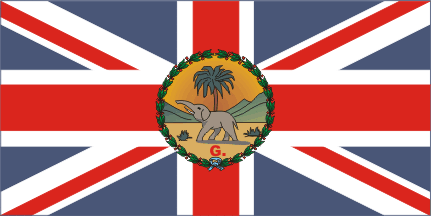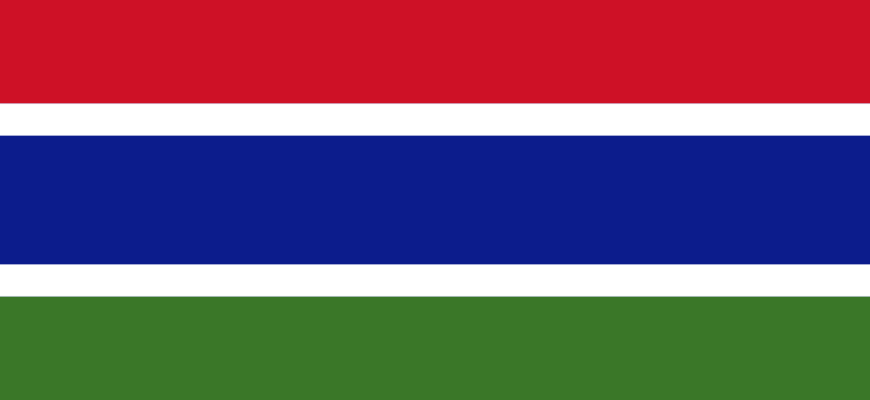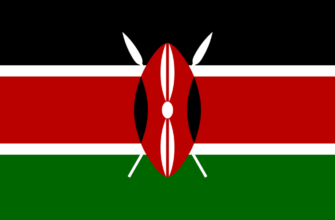The list of symbols of any country includes the national flag. It is most often painted in colors that conventionally indicate historically significant events, the form of political governance in the country, its geographic location, the economy and other important details relating to the formation of the state. The colors of the flag, as well as the presence of a coat of arms or emblem are fixed at the legislative level in the constitution of the country.
This is what the modern flag of The Gambia looks like:

History of the Gambian flag
Since the 16th century, the territory of present-day Gambia was colonized by the Dutch, the French, and the English, who built their trading settlements there. The Gambia was a British crown colony from 1807 and was governed by Sierra Leone in 1821. However, in 1843 the territory was returned to England.
The republic, while under British protectorate, used a flag representing the colonial possessions as its state symbol from 1870 to 1889. It was painted dark blue and had an image of the British flag in the upper left corner. On the right was the coat of arms of The Gambia, which showed the figure of an elephant with its trunk raised. The animal was against a background of palm trees, green mountains, and yellow sands.

At the bottom of the round emblem in Latin letters was written WEST AFRICA SETTLEMENTS.
In 1894 the Gambia was divided into two zones: the Protectorate and the Gambia Colony. From 1889 to 1965 the appearance of the cloth was not changed, but in connection with the division of lands the British Crown Colony changed the inscription on the emblem. The name of the settlements was replaced by a single capital letter G.

In 1959 a new Constitution was adopted and the Legislative Council was expanded, and in 1961 the future African republic was allowed to establish internal government with some restrictions. The self-government began to work on October 4, 1963, and on February 18, 1965, the state received independence within the borders of the British Commonwealth.



In the year of the acquisition of freedom, Gambian artists introduced the idea of introducing their own flag. The final version of the national symbols was authored by L. Tomasi, who was an employee of the Armorial Board of Great Britain.
In April 1970, The Gambia changed its form of government and became a republic.
Description
The rectangular shape of the Gambian flag has an aspect ratio of 2:3. The main background contains three wide stripes and two thin lines. The upper red part corresponds in width to the lower green part, while the central blue part is slightly reduced in size. White thin lines frame the blue stripe and are symmetrical about the central horizontal axis. The sizes of all the stripes on the flag relate to each other as 6:1:4:1:6.
Flag colors
The Gambian flag is divided into horizontal stripes and colored red, blue, and green. The central stripe is framed by thin white lines.
Meaning of the colors and symbol of the Gambian flag
The red color of the upper band is a symbol of the sun, which illuminates the territory. The blue in the center is in honor of the river of the same name, The Gambia. Its waters give life to the republic and the local population, with the river flowing between green jungle forests and red savannahs.
These natural areas are the basis of the territory of the state.
The green part along the lower edge of the cloth indicates the fertile lands along the riverbank. The white border of the central stripe on the flag is associated with prosperity, peace and unity among the nations.
The state symbols of the republic, by law, can be used for a variety of purposes on land and water. The flag has the right to raise the state services of the country, representatives and officials of the republic, as well as ordinary citizens. The three-striped cloth is the symbol of both the army and the navy of the state. The flag can be seen on private ships and those belonging to commercial maritime organizations.
General information about The Gambia
| Official language | English |
| Capital | Banjul |
| Territory | 10,380 km2 |
| Population | 1,878,999 people |
| Currency | dalasi |
| Phone Code | +220 |










I remember visiting The Gambia and being struck by its vibrant flag. Each color tells a story of the country’s history and culture. Seeing it fluttering was a proud moment, reminding me of the warm-hearted people I met there. It’s truly a beautiful symbol of unity!